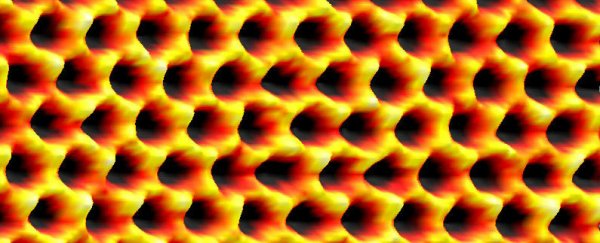Around 12 years ago, scientists thought that two-dimensional materials were impossible. Then a team in the UK discovered a lattice material known as graphene that was just one atom thick, and everything changed. But even though we've now accepted that 2D solids can exist, it's generally thought that such thin membranes would never hold in a liquid state.
But now physicists have conducted a computer simulation that predicts a brand new phase of matter: one-atom-thick 2D liquid. And their research suggests that it could theoretically exist when liquid gold stretches across the tiny pores of graphene. Think of it like a soap film over a solid bubble blower.
"Here the role of graphene is similar to circular rings through which children blow soap bubbles," lead researcher Pekka Koskinen from the University of Jyväskylä in Finland told the press. "The liquid state is possible when the edge of graphene pore stretches the metallic membrane and keeps it steady."
So while the gold atoms flow and change places, the surrounding graphene "retains the planarity of the liquid membrane," the press release explains.
It's important to note that this flat liquid hasn't been experimentally confirmed as yet, but the prediction pushes the boundaries of the different phases we think matter can exist in. And further testing could change the way we think about materials forever.
So how could such a flat liquid exist? First of all, the liquid material needs to spread out quickly enough to become 2D before fluctuations grow so large that the membrane ruptures.
But it also it requires a solid template that it bonds strongly with and that stays stable at high temperatures to hold it in place. The computer simulations predict that the combination of graphene and liquid gold stretched across its tiny hexagonal pores meet these criteria, and can in theory hold in place a two-dimensional liquid material.
Of course, this flat liquid only exists in a computer model for now, and to demonstrate that such a phase of matter could really exist, the team will now have to experimentally create the material. The results have been published in the journal Nanoscale.
"Unfortunately, simulations suggest that the flat liquid is volatile," says Koskinen. "In experiments the liquid membrane might burst too early, like a soap bubble that bursts before one gets a proper look at it."
"But again, even graphene was previously considered too unstable to exist," she adds.
